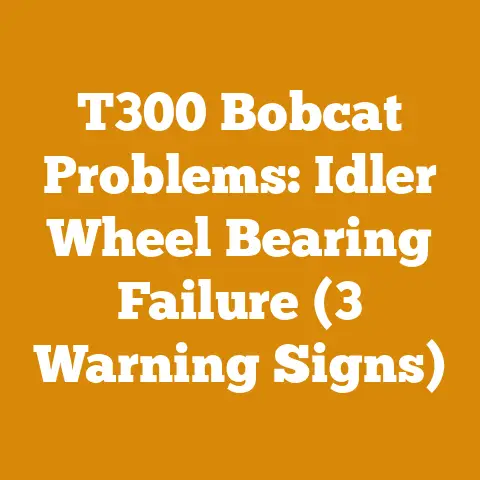Danner Flashpoint II Boots for Logging (5 Hotshot Tips)
Let’s dive into the world of logging boots and how the right pair, like the Danner Flashpoint II, can significantly impact your efficiency and safety in the field. But more than just gear recommendations, I want to share some insights on how to measure your success in logging and firewood preparation, turning raw data into actionable improvements.
Danner Flashpoint II Boots for Logging (5 Hotshot Tips)
Choosing the right logging boots is a crucial decision that impacts not only your comfort but also your safety and efficiency in the field. The Danner Flashpoint II boots are a popular choice among loggers and wildland firefighters, known for their durability, support, and protective features. However, simply owning a great pair of boots isn’t enough. You need to combine them with smart practices and a data-driven approach to maximize your productivity and minimize risks.
Here are five “Hotshot Tips” to get the most out of your Danner Flashpoint II boots while optimizing your logging and firewood preparation projects, interwoven with key metrics to track your progress:
1. Footwear Fit and Maintenance: The Foundation of Success
Why it Matters: Ill-fitting boots lead to blisters, fatigue, and potential injuries, which directly impacts your working hours and overall productivity. Proper maintenance extends the life of your boots, saving you money in the long run and ensuring they perform optimally.
Hotshot Tip: Don’t just buy your boots online. Visit a store where you can get professionally fitted. Wear the same socks you plan to wear while logging. Walk around the store and pay attention to any pressure points or areas of discomfort.
Metrics to Track:
- Boot Lifespan (Months): How long your boots last before needing replacement or significant repairs.
- Definition: The number of months from the date of purchase to the date the boots become unusable for logging work due to wear and tear.
- Importance: Longer boot lifespan translates to lower annual footwear costs.
- Interpretation: A shorter lifespan than expected (e.g., less than 12 months) indicates potential issues with boot quality, usage patterns (e.g., working in excessively abrasive environments), or inadequate maintenance.
- Relationship to Other Metrics: Directly impacts the overall cost per cord of wood processed (see Metric 5).
- Maintenance Time (Hours/Month): Time spent cleaning, conditioning, and repairing your boots.
- Definition: The total number of hours per month dedicated to boot maintenance activities.
- Importance: Tracks the labor investment required to keep your boots in good condition.
- Interpretation: A high maintenance time may suggest that your boots are subjected to harsh conditions or that you are neglecting regular maintenance, leading to more extensive repairs.
- Relationship to Other Metrics: Affects the boot lifespan and overall cost. Neglecting maintenance can shorten the lifespan and increase replacement costs.
- Comfort Rating (1-5 Scale): A subjective rating of your boot comfort after each workday.
- Definition: A self-assessed rating on a scale of 1 to 5, where 1 represents extreme discomfort and 5 represents excellent comfort.
- Importance: Provides a qualitative measure of how well your boots are performing in terms of comfort and support.
- Interpretation: Consistently low ratings indicate potential fit issues, inadequate sock selection, or the need for more supportive insoles.
- Relationship to Other Metrics: Correlates with the number of breaks needed during the workday (see Metric 2 in Tip 2) and overall productivity.
My Experience: I’ve learned the hard way that a poorly fitted boot can ruin an entire day. I once rushed into buying a pair online without trying them on, and after just a few hours of felling trees, I developed blisters that sidelined me for a week. Now, I always prioritize a professional fitting and meticulously track the lifespan of my boots. I also keep a log of the time I spend on maintenance – it’s surprising how quickly those 15-minute cleaning sessions add up!
Example: Let’s say you purchased your Danner Flashpoint II boots for $350. You spend an average of 1 hour per month on cleaning and conditioning (valued at your hourly labor rate of $25). If the boots last for 18 months, the total cost is $350 + (18 months * 1 hour/month * $25/hour) = $790. Tracking this helps you compare different boot models and maintenance routines.
2. Ergonomics and Safety: Preventing Injuries and Maximizing Efficiency
Why it Matters: Logging is physically demanding. Wearing supportive boots like the Danner Flashpoint II helps reduce strain on your feet, ankles, and back. Combining this with proper ergonomic practices and safety protocols minimizes the risk of injuries, keeping you working consistently and efficiently.
Hotshot Tip: Pay attention to your posture and lifting techniques. Use your legs, not your back, when lifting logs. Take frequent breaks to stretch and rehydrate. Invest in supportive insoles if needed.
Metrics to Track:
- Injury Frequency (Incidents/Month): The number of work-related injuries sustained per month.
- Definition: The count of injuries requiring medical attention or resulting in lost work time.
- Importance: A direct indicator of safety performance and the effectiveness of safety protocols.
- Interpretation: An increasing injury frequency signals a need to review safety procedures, equipment maintenance, and training programs.
- Relationship to Other Metrics: Correlates with downtime (see Metric 4) and overall productivity.
- Break Frequency (Breaks/Day): The number of breaks taken during a typical workday.
- Definition: The number of rest periods taken during a standard workday, excluding lunch breaks.
- Importance: Indicates the level of physical strain and the need for recovery.
- Interpretation: A high break frequency suggests that the work is excessively demanding or that the boots are not providing adequate support.
- Relationship to Other Metrics: Can be linked to comfort rating (see Metric 3 in Tip 1) and overall productivity.
- Perceived Exertion Rate (RPE) (1-10 Scale): A subjective rating of how hard you feel you are working on a scale of 1 to 10.
- Definition: A self-reported measure of the intensity of your physical effort, ranging from 1 (very light) to 10 (maximal exertion).
- Importance: Provides a subjective assessment of workload and fatigue levels.
- Interpretation: Consistently high RPE scores indicate a need to adjust work pace, improve equipment, or enhance physical conditioning.
- Relationship to Other Metrics: Can be compared with productivity metrics to assess efficiency. Working harder doesn’t always mean producing more.
My Experience: I remember a time when I ignored early signs of back pain, thinking I could push through it. It resulted in a pulled muscle that kept me out of the woods for weeks. Now, I meticulously track my break frequency and RPE. I also use a fitness tracker to monitor my heart rate during work, providing objective data on my exertion levels.
Example: You track your injury frequency and notice a spike in back strains during firewood splitting season. Analyzing this data prompts you to invest in a log splitter with a better ergonomic design and provide training on proper lifting techniques. This reduces injury frequency and improves overall productivity.
3. Terrain Adaptation and Traction: Maintaining Stability and Control
Why it Matters: Logging often involves navigating uneven and slippery terrain. The aggressive tread of boots like the Danner Flashpoint II provides essential traction. Understanding how well your boots perform in different conditions and adapting your techniques accordingly is crucial for preventing falls and maintaining control.
Hotshot Tip: Test your boots on various surfaces (mud, snow, steep slopes) to understand their limits. Use trekking poles for added stability on challenging terrain. Sharpen your chainsaw chain regularly to maintain optimal cutting efficiency and reduce the risk of kickback.
Metrics to Track:
- Slip and Fall Incidents (Incidents/Month): The number of times you slip or fall while working.
- Definition: The count of instances where you lose your footing and either slip or fall to the ground.
- Importance: A direct measure of traction performance and the risk of injury.
- Interpretation: A high number of slip and fall incidents indicates potential issues with boot traction, terrain conditions, or work practices.
- Relationship to Other Metrics: Correlates with injury frequency (see Metric 1 in Tip 2) and downtime.
- Terrain Difficulty Rating (1-5 Scale): A subjective assessment of the difficulty of the terrain you are working on.
- Definition: A self-assessed rating on a scale of 1 to 5, where 1 represents easy terrain and 5 represents extremely challenging terrain.
- Importance: Provides context for interpreting slip and fall incidents and other performance metrics.
- Interpretation: A high number of slip and fall incidents on difficult terrain may be acceptable, but a high number on easy terrain indicates a problem with boot traction or work practices.
- Relationship to Other Metrics: Helps to explain variations in productivity and injury rates across different work sites.
- Chain Saw Kickback Frequency (Incidents/Month): The number of times your chainsaw experiences kickback.
- Definition: The count of instances where the chainsaw blade unexpectedly kicks back towards you.
- Importance: A critical indicator of chainsaw safety and the risk of serious injury.
- Interpretation: A high kickback frequency suggests that the chain is dull, the cutting technique is incorrect, or the wood is under tension.
- Relationship to Other Metrics: Can be linked to injury frequency and downtime.
My Experience: I once underestimated the slipperiness of a muddy slope and took a nasty fall, luckily avoiding serious injury. Since then, I’ve become much more attentive to terrain conditions and always assess the traction of my boots before starting work. I also started using trekking poles, which have made a huge difference in my stability.
Example: You track slip and fall incidents and notice a correlation with wet weather conditions. This prompts you to invest in traction aids like ice cleats or chains for your boots during winter months, reducing the risk of falls and improving safety.
4. Environmental Protection and Sustainability: Minimizing Impact and Promoting Responsible Logging
Why it Matters: As stewards of the land, loggers have a responsibility to minimize their environmental impact. Using appropriate gear, like the Danner Flashpoint II with its durable construction, reduces the need for frequent replacements and contributes to sustainability. Tracking your environmental footprint and implementing responsible logging practices is crucial for long-term forest health.
Hotshot Tip: Use biodegradable chainsaw oil and bar lubricant. Avoid working in sensitive areas during wet conditions to minimize soil erosion. Practice selective logging to promote forest regeneration.
Metrics to Track:
- Fuel Consumption (Gallons/Cord): The amount of fuel consumed per cord of wood processed.
- Definition: The number of gallons of fuel (gasoline, diesel, etc.) used to harvest and process one cord of wood.
- Importance: A measure of energy efficiency and environmental impact.
- Interpretation: High fuel consumption indicates potential issues with equipment maintenance, inefficient work practices, or the need for more fuel-efficient tools.
- Relationship to Other Metrics: Directly impacts the cost per cord of wood processed (see Metric 5) and the carbon footprint of your operations.
- Wood Waste (Percentage): The percentage of harvested wood that is left unused or discarded.
- Definition: The proportion of harvested wood that is not converted into usable products (firewood, lumber, etc.).
- Importance: A measure of resource utilization and efficiency.
- Interpretation: High wood waste indicates potential issues with harvesting techniques, processing methods, or market demand for certain wood types.
- Relationship to Other Metrics: Impacts the overall yield and profitability of your operations.
- Soil Disturbance Area (Square Feet/Cord): The area of soil disturbed per cord of wood processed.
- Definition: The area of soil that is disturbed or compacted by logging activities, measured in square feet per cord of wood harvested.
- Importance: A measure of the environmental impact on soil health and forest regeneration.
- Interpretation: High soil disturbance indicates potential issues with logging techniques, equipment selection, or terrain management.
- Relationship to Other Metrics: Can be linked to erosion rates and the long-term health of the forest ecosystem.
My Experience: I’ve become increasingly aware of the environmental impact of my logging activities. I now meticulously track my fuel consumption and wood waste. I also switched to using biodegradable chainsaw oil and have implemented selective logging practices to promote forest regeneration.
Example: You track your fuel consumption and discover that your old chainsaw is significantly less fuel-efficient than a newer model. Investing in a more efficient chainsaw reduces fuel consumption and lowers your carbon footprint. You also find that you’re wasting a lot of small branches. You decide to invest in a chipper and sell the wood chips as mulch, turning waste into a valuable product.
5. Cost Analysis and Profitability: Turning Data into Dollars
Why it Matters: Ultimately, logging and firewood preparation are businesses. Tracking your costs and profitability is essential for ensuring long-term financial sustainability. Understanding the true cost of each cord of wood you produce allows you to make informed decisions about pricing, investments, and operational improvements.
Hotshot Tip: Track all your expenses, including fuel, equipment maintenance, boot replacements, and labor. Calculate your cost per cord of wood and compare it to your selling price. Identify areas where you can reduce costs and increase efficiency.
Metrics to Track:
- Cost Per Cord (Dollars/Cord): The total cost of producing one cord of wood.
- Definition: The sum of all expenses (fuel, equipment, labor, permits, etc.) divided by the number of cords of wood produced.
- Importance: A critical measure of profitability and operational efficiency.
- Interpretation: High cost per cord indicates potential issues with inefficient processes, high input costs, or low productivity.
- Relationship to Other Metrics: Integrates all other metrics, providing a holistic view of your operations.
- Revenue Per Cord (Dollars/Cord): The amount of revenue generated from selling one cord of wood.
- Definition: The selling price of one cord of wood.
- Importance: Determines the profitability of your operations.
- Interpretation: Comparing revenue per cord with cost per cord reveals your profit margin.
- Relationship to Other Metrics: Directly impacts your overall profitability and the sustainability of your business.
- Equipment Downtime (Hours/Month): The total number of hours your equipment is out of service due to repairs or maintenance.
- Definition: The cumulative time that your chainsaws, skidders, splitters, or other equipment are unavailable for use due to breakdowns or scheduled maintenance.
- Importance: A measure of equipment reliability and the impact of downtime on productivity.
- Interpretation: High downtime indicates potential issues with equipment maintenance, the need for equipment upgrades, or inadequate backup equipment.
- Relationship to Other Metrics: Directly impacts productivity and cost per cord.
My Experience: I used to rely on gut feeling to price my firewood. But after tracking my costs meticulously, I realized I was significantly underpricing my product. By raising my prices slightly and implementing more efficient processes, I significantly increased my profitability.
Example: You track your cost per cord and find that your equipment downtime is significantly impacting your profitability. Investing in preventative maintenance and having backup equipment on hand reduces downtime and improves your bottom line. You analyze your revenue per cord and discover that selling seasoned firewood at a premium price significantly increases your profitability compared to selling green firewood.
Bringing It All Together: A Case Study
Let’s look at a hypothetical case study to illustrate how these metrics can be applied in practice.
Project: Preparing 50 cords of firewood for the winter season.
Equipment: Danner Flashpoint II boots, Stihl MS 261 chainsaw, hydraulic log splitter.
Data Collected:
- Boot Lifespan: 15 months (Danner Flashpoint II boots)
- Maintenance Time: 1.5 hours/month (boots)
- Comfort Rating: Average of 4.5 (out of 5)
- Injury Frequency: 0 (no injuries)
- Break Frequency: Average of 3 breaks per day
- Perceived Exertion Rate: Average of 6 (out of 10)
- Slip and Fall Incidents: 1 (minor slip, no injury)
- Terrain Difficulty Rating: Average of 3 (moderate)
- Chain Saw Kickback Frequency: 2 (minor kickbacks)
- Fuel Consumption: 2 gallons/cord
- Wood Waste: 5%
- Soil Disturbance Area: 10 sq ft/cord
- Cost Per Cord: $120
- Revenue Per Cord: $200
- Equipment Downtime: 5 hours (chainsaw maintenance)
Analysis:
- The Danner Flashpoint II boots performed well in terms of comfort and durability. The high comfort rating and long lifespan contributed to consistent productivity.
- The low injury frequency indicates effective safety practices and appropriate equipment selection.
- The fuel consumption is within an acceptable range, but there is potential for improvement by optimizing chainsaw maintenance and cutting techniques.
- The wood waste is relatively low, indicating efficient resource utilization.
- The soil disturbance area is manageable, suggesting responsible logging practices.
- The cost per cord is competitive, and the revenue per cord generates a healthy profit margin.
- The equipment downtime is minimal, but regular maintenance is crucial to prevent unexpected breakdowns.
Actionable Insights:
- Continue using the Danner Flashpoint II boots and maintain a consistent maintenance schedule.
- Reinforce safety protocols and provide regular training on chainsaw safety and ergonomic practices.
- Explore options for reducing fuel consumption, such as using a more fuel-efficient chainsaw chain or optimizing cutting techniques.
- Continue to minimize wood waste by finding markets for smaller pieces of wood or using them for personal projects.
- Monitor soil disturbance and implement best practices for erosion control.
- Track costs and revenue closely to identify opportunities for further optimization.
Conclusion:
By combining the comfort, support, and durability of Danner Flashpoint II boots with a data-driven approach to logging and firewood preparation, you can significantly improve your efficiency, safety, and profitability. Tracking key metrics, analyzing the data, and implementing actionable insights will help you make informed decisions, optimize your operations, and achieve long-term success in the wood industry. Remember, the right gear is only part of the equation. It’s the combination of quality equipment, smart practices, and a commitment to continuous improvement that truly sets you apart.






